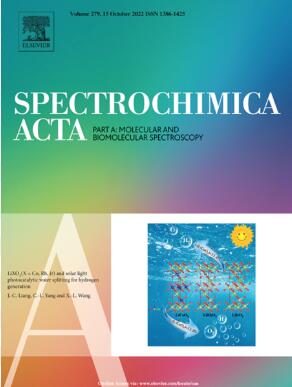Metabolic fingerprinting of human plasma in dementia: A pilot study of metabolome decomposition
IF 4.3
2区 化学
Q1 SPECTROSCOPY
Spectrochimica Acta Part A: Molecular and Biomolecular Spectroscopy
Pub Date : 2025-06-02
DOI:10.1016/j.saa.2025.126507
引用次数: 0
Abstract
Background
As the number of people with dementia grows, it becomes even more important to improve how it is diagnosed and treated. Metabolomics, the study of small molecule metabolites in biological systems, helps us learn a lot about dementia by revealing changes in the brain’s systems through blood plasma research.
Objective
The objective of this study is to clarify the changes in metabolism that are linked to dementia. This will be achieved by using metabolic fingerprinting techniques on human plasma to differentiate between patients with dementia and individuals who have normal cognitive function.
Methods
This study used data from the Birjand Longitudinal Aging Study and high-tech Raman Spectroscopy, as well as multivariate statistical methods such as PCA and OPLS-DA. The study looked at 34 people with dementia and 34 people who did not have any cognitive damage.
Results
Metabolic fingerprints distinguished two groups with extremely distinct metabolic characteristics. Main findings demonstrate that oxidative stress and energy metabolism metabolites have changed significantly. OPLS-DA distinguished healthy and dementia samples with high accuracy and sensitivity. Both the expected high model accuracy and the clear score plot split confirmed this.
Conclusion
The metabolic deviations detected offer a deeper understanding of the biochemical processes associated with dementia. These results enhance our understanding of dementia-related biochemical changes and underscore the exploratory potential of Raman-based metabolomic fingerprinting as a complementary, non-invasive approach for identifying broader functional group-level alterations.

痴呆患者血浆代谢指纹图谱:代谢组分解的初步研究
随着痴呆症患者人数的增加,改善痴呆症的诊断和治疗方法变得更加重要。代谢组学,研究生物系统中的小分子代谢物,通过血浆研究揭示大脑系统的变化,帮助我们了解很多关于痴呆症的知识。目的本研究的目的是阐明与痴呆有关的代谢变化。这将通过对人体血浆使用代谢指纹技术来区分痴呆症患者和具有正常认知功能的个体来实现。方法采用Birjand纵向老化研究数据和高科技拉曼光谱,以及PCA和OPLS-DA等多元统计方法。这项研究观察了34名痴呆症患者和34名没有任何认知损伤的人。结果代谢指纹图谱对两组的代谢特征区分非常明显。主要研究结果表明,氧化应激和能量代谢代谢产物发生了显著变化。OPLS-DA区分健康和痴呆样品具有较高的准确性和敏感性。预期的高模型精度和清晰的分数图分割都证实了这一点。结论检测到的代谢偏差有助于深入了解与痴呆相关的生化过程。这些结果增强了我们对痴呆症相关生化变化的理解,并强调了基于拉曼代谢组学指纹识别作为一种互补的、非侵入性的方法来识别更广泛的功能群水平变化的探索潜力。
本文章由计算机程序翻译,如有差异,请以英文原文为准。
求助全文
约1分钟内获得全文
求助全文
来源期刊
CiteScore
8.40
自引率
11.40%
发文量
1364
审稿时长
40 days
期刊介绍:
Spectrochimica Acta, Part A: Molecular and Biomolecular Spectroscopy (SAA) is an interdisciplinary journal which spans from basic to applied aspects of optical spectroscopy in chemistry, medicine, biology, and materials science.
The journal publishes original scientific papers that feature high-quality spectroscopic data and analysis. From the broad range of optical spectroscopies, the emphasis is on electronic, vibrational or rotational spectra of molecules, rather than on spectroscopy based on magnetic moments.
Criteria for publication in SAA are novelty, uniqueness, and outstanding quality. Routine applications of spectroscopic techniques and computational methods are not appropriate.
Topics of particular interest of Spectrochimica Acta Part A include, but are not limited to:
Spectroscopy and dynamics of bioanalytical, biomedical, environmental, and atmospheric sciences,
Novel experimental techniques or instrumentation for molecular spectroscopy,
Novel theoretical and computational methods,
Novel applications in photochemistry and photobiology,
Novel interpretational approaches as well as advances in data analysis based on electronic or vibrational spectroscopy.

 求助内容:
求助内容: 应助结果提醒方式:
应助结果提醒方式:


